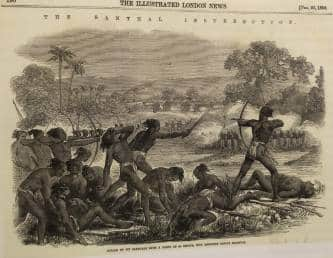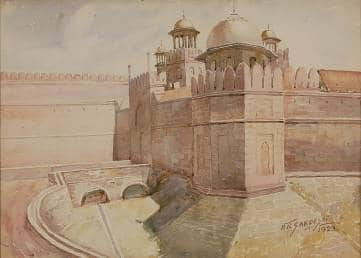



Near-naked bodies of men armed with bows and arrows fighting valiantly against gun-wielding soldiers of British forces was an illustration in a London newspaper on February 23, 1856. Headlined "The Santhal Insurrection", the picture in The Illustrated London News described an attack by 600 Santhals on a party of 50 sepoys of the 40th native infantry regiment. The attack came only months before the First War of Independence in 1857.
 The Great Santhal Hul Rebellion of 1855, illustrated by an unknown artist, was published in Illustrated London News in 1856. (Photo courtesy DAG)
The Great Santhal Hul Rebellion of 1855, illustrated by an unknown artist, was published in Illustrated London News in 1856. (Photo courtesy DAG)While the Sepoy Mutiny of 1857 is a major historical landmark in India's freedom movement, little is known about many such revolts across the country that influenced the First War of Independence. One such rebellion is the Great Santhal Hul of 1855 led by the tribes from present-day Jharkhand, Bihar and West Bengal. Facing huge debts forced by an unfair British administration, thousands of Santhals rose in rebellion against the Raj. More than 15,000 tribespeople were killed by the army of the colonisers and many others were convicted and exiled to the Andamans.
The story of the Santhals is part of a new art exhibition on India's freedom struggle, that opened on October 6 in the national capital, to celebrate 75 years of India's independence. Mounted at the Bikaner House, the show, 'March to Freedom', by independent art gallery DAG (formerly Delhi Art Gallery), gathers an expansive array of artworks, about 160 of them, to reveal the various struggles, like that of the Santhals, that sparked within many layers of the oppressed Indian society leading to the independence of the country.
People's army"The united Santhals, representing the toiling masses, created the first people's army against the powerful British government," says Maroona Murmu, who teaches history at the Jadavpur University in Kolkata. Writing in an accompanying book on the exhibition, Prof. Murmu says, the Santhals, who had turned the forests into cultivable habitations, were determined the time had come to establish an independent Santhal Raj. Though they lost, the tribals won a self-governing district, Santhal Pargana, which today constitutes five tribal-dominated districts of Jharkhand.
The revolt of the Santhals illustrated by an unidentified artist was published by the London newspaper several months after the event owing to the time it took for the news to travel from the interiors of India to England. The DAG collection around India's freedom struggle comprises newspaper reports, posters, calendars, etchings, engravings, paintings, prints and bronze busts of prominent figures in the freedom movement.
The Santhals were not the only people's army fighting against imperialism. There were Dalits and women at the centre of many rebellions that have stayed out of the mainstream narrative. The Vellore Mutiny of 1806 by Hindu and Muslim soldiers was triggered by the ban of Madras Army general John Craddock on wearing beards, traditional turbans and religious marks on foreheads. The Great Kuki Rebellion of 1917-19 in the Imphal Valley for independence was caused by the British attempt to recruit labour for World War I from the hill tribes in the Northeast. Historians consider the Kuki rebellion as the first armed guerrilla war faced by British forces in India.
Reinterpreting history"'March to Freedom' reinterprets the well-known story of the Indian freedom struggle and anti-colonial movement through works of art and some historical artefacts," says historian and the exhibition's curator, Mrinalini Venkateswaran. "Drawn from the collections of DAG, they range from 18th and 19th century European paintings and prints to lesser-known works by Indian artists that merit greater recognition, alongside some iconic pieces," adds Venkateswaran, a Fellow of the Royal Asiatic Society, the UK.
 Artist NR Sardesai's 1929 work in watercolour on paper portrays the Red Fort's Lahore Gate. (Photo courtesy DAG)
Artist NR Sardesai's 1929 work in watercolour on paper portrays the Red Fort's Lahore Gate. (Photo courtesy DAG)Among the Indian artists interpreting independence and the struggle are Bengali painter Satish Sinha, whose work in watercolour and ink on paper in the exhibition shows a refugee camp in south Calcutta in 1946, self-taught Assamese artist Hemanta Misra who painted Boatmen on the Brahmaputra in 1947, Chittagong-born artist Sudhir Khastgir, who trained under the masters Nandalal Bose and Abanindranath Tagore, and NR Sardesai, whose 1929 work in watercolour on paper portrays the Red Fort's Lahore Gate without any signs of life.
First held at the Indian Museum in Kolkata during July-September this year, "March to Freedom" also has works showing the daily labour of ordinary people, like the struggling fishermen on the waters in Bengal by painters Biren De and Haren Das, both born in Bangladesh. Another by an unidentified Thanjavur artist from 1770 shows a silk weaver collecting thread from his wife. The same Thanjavur artist has a similar painting, also from 1770, of an accountant and his wife.
"Our goal has been to uncover the hidden, or less familiar aspects of a story that many of us know so well that we think it is a self-evident truth, and seldom pause to reflect on it," says DAG CEO Ashish Anand. "Not all of us are interested in the huge body of scholarship that exists about the nationalist movement," he adds.
 'Slum Musician' (1957) by Chittagong-born painter-sculptor Sudhir Khastgir, who trained under the masters Nandalal Bose and Abanindranath Tagore. (Photo courtesy DAG)
'Slum Musician' (1957) by Chittagong-born painter-sculptor Sudhir Khastgir, who trained under the masters Nandalal Bose and Abanindranath Tagore. (Photo courtesy DAG)Bengali artist Chittaprosad, known for his famous drawings of the Bengal Famine of 1943 seized and burnt by the colonial rulers, has one painting from 1945. Titled Lezim, the ink on paper portrays a group of turban-clad men presenting a folk dance of Maharashtra called lezim, named after the jingling cymbals the performers carry.
Continuing conversationThe exhibition greatly contributes to the continuing conversation on the independence struggle with its deft intermixing of space and time to offer a contemporary dimension to the word, freedom. Venkateswaran explains that there is a "deliberate ambiguity" in the meaning of the show's title, "March to Freedom". "Is it a statement of fact, an exhortation towards a goal within sight, or an idealistic aspiration?" Venkateswaran says, raising questions, which are a recurring theme of the exhibition, to underline the difference between a society's aspirations and outcome, and goals and challenges.
One of the questions relates to the state of farmers as reflected in well-known artist KS Kulkarni's 1950 painting, an oil on canvas that has a farmer and a pair of oxen ploughing a field. A second Chittaprosad work in the exhibition, an untitled watercolour from 1950 that confronts the reality of natural resources, poses the question of tribal and land rights.
The exhibition is on show till October 28 at the Bikaner House, New DelhiDiscover the latest Business News, Sensex, and Nifty updates. Obtain Personal Finance insights, tax queries, and expert opinions on Moneycontrol or download the Moneycontrol App to stay updated!
Find the best of Al News in one place, specially curated for you every weekend.
Stay on top of the latest tech trends and biggest startup news.